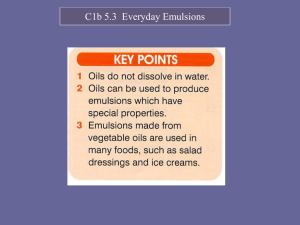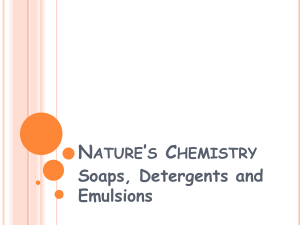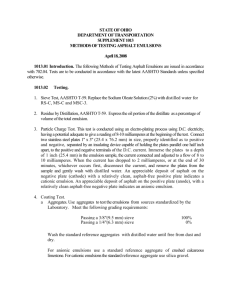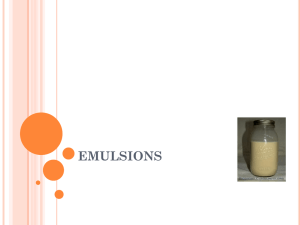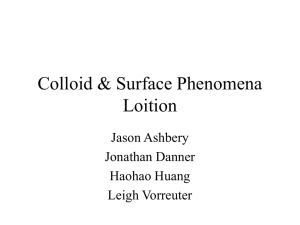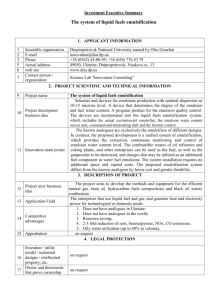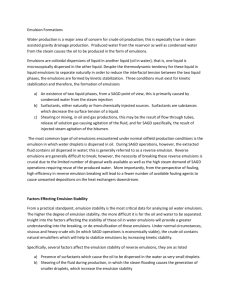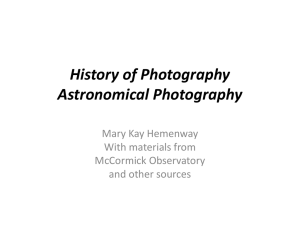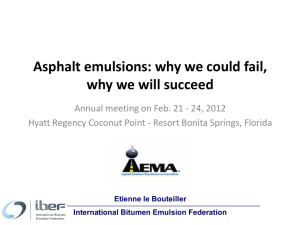C3 Semi-Solids 2015
advertisement
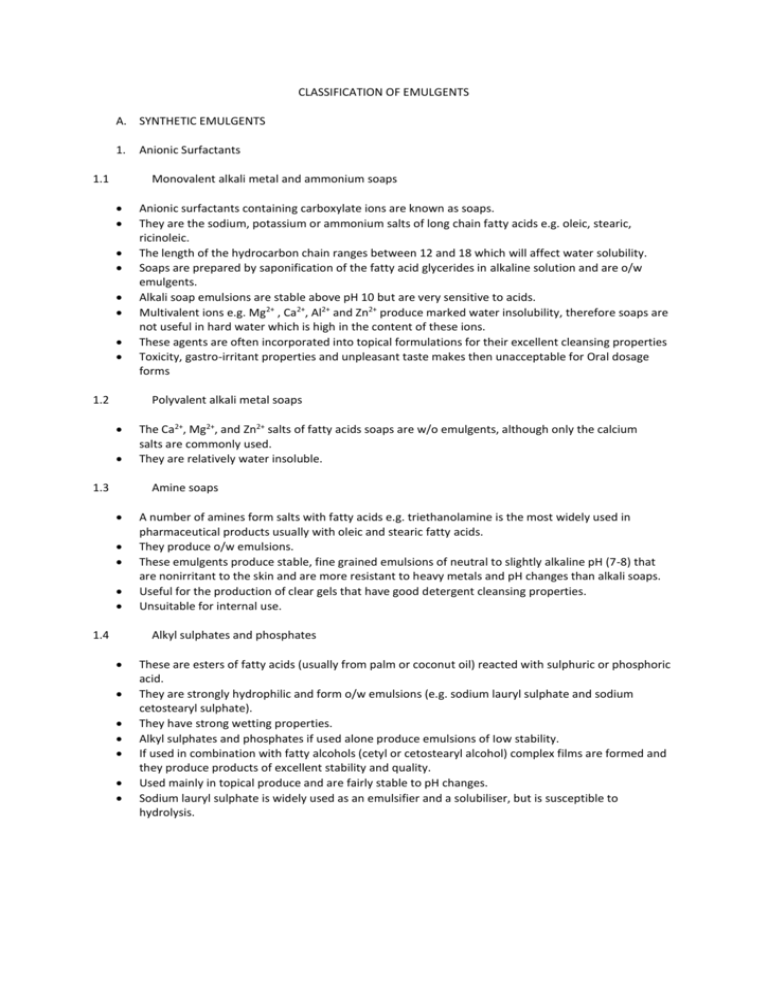
CLASSIFICATION OF EMULGENTS A. SYNTHETIC EMULGENTS 1. 1.1 Anionic Surfactants Monovalent alkali metal and ammonium soaps 1.2 Anionic surfactants containing carboxylate ions are known as soaps. They are the sodium, potassium or ammonium salts of long chain fatty acids e.g. oleic, stearic, ricinoleic. The length of the hydrocarbon chain ranges between 12 and 18 which will affect water solubility. Soaps are prepared by saponification of the fatty acid glycerides in alkaline solution and are o/w emulgents. Alkali soap emulsions are stable above pH 10 but are very sensitive to acids. Multivalent ions e.g. Mg2+ , Ca2+, Al2+ and Zn2+ produce marked water insolubility, therefore soaps are not useful in hard water which is high in the content of these ions. These agents are often incorporated into topical formulations for their excellent cleansing properties Toxicity, gastro-irritant properties and unpleasant taste makes then unacceptable for Oral dosage forms Polyvalent alkali metal soaps 1.3 The Ca2+, Mg2+, and Zn2+ salts of fatty acids soaps are w/o emulgents, although only the calcium salts are commonly used. They are relatively water insoluble. Amine soaps 1.4 A number of amines form salts with fatty acids e.g. triethanolamine is the most widely used in pharmaceutical products usually with oleic and stearic fatty acids. They produce o/w emulsions. These emulgents produce stable, fine grained emulsions of neutral to slightly alkaline pH (7-8) that are nonirritant to the skin and are more resistant to heavy metals and pH changes than alkali soaps. Useful for the production of clear gels that have good detergent cleansing properties. Unsuitable for internal use. Alkyl sulphates and phosphates These are esters of fatty acids (usually from palm or coconut oil) reacted with sulphuric or phosphoric acid. They are strongly hydrophilic and form o/w emulsions (e.g. sodium lauryl sulphate and sodium cetostearyl sulphate). They have strong wetting properties. Alkyl sulphates and phosphates if used alone produce emulsions of Iow stability. If used in combination with fatty alcohols (cetyl or cetostearyl alcohol) complex films are formed and they produce products of excellent stability and quality. Used mainly in topical produce and are fairly stable to pH changes. Sodium lauryl sulphate is widely used as an emulsifier and a solubiliser, but is susceptible to hydrolysis. 2. CATIONIC SURFACTANTS The most important in this category are the quaternary ammonium compounds (QAC's) which are o/w emulgents. When used with fatty alcohols they produce good, stable emulsions. The most useful QAC is cetrimide which is included in a cationic emulsifying wax which is most stable in the pH 3-7 range. The QAC's and the pyridinium cationic surfactants have bactericidal activity against a wide range of gram-positive and some gram-negative organisms. Good emulsions are formed with cetyl alcohol as the secondary emulsifier producing o/w emulsions for external application (cleansers). Stearyl trimethyl ammonium chloride has good hair conditioning properties as the cation is attracted to the negative charge of the keratin. The QAC's (cetrimide and benzalkonium chloride) are used as emulqents and as preservatives. Cetylpyridinium bromide (a pyridinium salt) is used as a disinfectant. 3. NONIONIC SURFACTANTS This is the main class of surfactants used in pharmaceutical formulation since they have many advantages with respect to compatibility, stability and potential toxicity. they do not ionize to any great extent in solution and are compatible with both anionic and cationic substances. They are stable in the presence of electrolytes and to pH changes. In excess they do tend to preservatives with phenolic or carboxylic acid groups. They have low foaming and low cleansing properties but are good emulqents. 3.1 3.2 3.3 Glycol and glycerol esters e.g. glyceryl monostearate They are of a strongly hydrophilic nature. They produce poor w/o emulsions when used alone. They are usually combined with other agents (eg soaps) to form a stable complex film. Glyceryl monostearate is an excellent emollient and confers smoothness and fine texture on an emulsion. Sorbitan esters (Spans) Formed by the dehydration of sorbitol to form the cyclic sorbitol moiety, and subsequent esterification with free fatty acids. The hydrophobic groups predominate, so they are oil soluble and are w/o emulgents. The lipophilic character is proportional to the length of the acid chain, allowing products of varying character (Span 20, 40, 80 etc). They are used alone to form w/o emulsions, or in combination with polysorbates to form either o/w or w/o systems. Polysorbates (Tweens) Tweens are formed by the condensation of the sorbitan esters (Spans) with polyoxyethylene. (CH2-O- CH2)n - they are the polyethylene glycol derivatives of sorbitan esters. 3.4 3.5 The number and length of the polyoxyethylene groups determines hydrophilicity, allowing products of different character to be synthesized. The polysorbates produce fine-textured o/w emulsions of good stability with no oral or topical irritancy. They are suitable for oral emulsions of mineral, vegetable and fish liver oils They are also useful for creams and ointments that are water soluble or readily removed by washing. Frequently used in combination with the sorbitan esters to produce o/w or w/o emulsions of different textures and consistencies. Polysorbate 80 is often used for parenteral emulsions and to emulsify dietary oils and fats (TPN). Polyoxyethylene Esters (macrogol esters) They have a predominantly hydrophilic character and form o/w emulsions. They are synthesized from long-chain ethylene oxide polymers. The ratio of hydrophilic to lipophilic character depends on the number of oxyethylene groups present. More groups confer greater hydrophilic character e.g. PEG-400 stearate means that we have the stearic acid ester (n:17) and 400 oxyethylene groups. They can be blended with other emulgents to obtain a particular HLB character for emulsions. Polyoxyethylene Ethers (macrogol ethers) These are condensation products of polyethylene glycol and fatty alcohols. The macrogol that is most widely used as an emulgent is Cetomacroqol 1000. These products tend to be mixtures of polymers of similar molecular weights eg. Cetomacrogol 1000 has n=15 or 17 and m= 20-24. Like sodium lauryl sulphate and cetrimide, it is too hydrophilic to produce stable emulsions when used alone, but produces an excellent emulsion when used with the hydrophobic cetostearyl alcohol. These emulsions are compatible with many anionic, cationic and nonionic medicaments. Used in the form of cetomacrogol emulsifying wax in o/w emulsions and as a , solubilising agent for volatile oils. These agents are used in gels and as cleansers in shampoos and cosmetics. 4. AMPHOTERIC/AMPHOLYTIC SURFACTANTS Ionic characteristics depend on the pH of the system: cationic in acid and anionic in alkaline, zwitterion in neutral. This class includes natural phospholipids such as lecithin as well as various and proteins. They are not widely used as emulsifiers but are used as bactericidal detergents and nonirritant shampoos. B. NATURAL EMULGENTS 1. POLYSACCHARIDES 1.1 Natural polysaccharides Acacia is the best emulgent for extemporaneously produced oral o/w emulsions. Used at concentrations of between 5 - 10% and produces emulsions of low viscosity. Susceptible to creaming because of low viscosity, so are often thickened with other agents such as traqacanth. Acacia emulsions are too sticky for external use. Tragacanth produces coarse emulsions and its emulsifying ability is due mainly to the high viscosity of its mucilages. Used mainly as an emulsion stabilizer (0.5 - 1%), particularly for acacia emulsions. Sodium alqinate also produces solutions of a high viscosity. Used mainly as an emulsion stabilizer (1 - 5%), particularly for acacia emulsions. 1.2 Semisynthetic polysaccharides Methylcellulose is a water-soluble cellulose resulting from the methylation of cellulose. The name is usually followed by a number that gives an indication of the viscosity of a 2% aqueous solution at 200C. Low-viscosity grades are suitable as emulgents and emulsion stabilizers. Sodium carboxymethylcellulose is used as an emulsion stabilizer. 2. STEROL-CONTAINING SUBSTANCES Derived from animal sources and include beeswax, wool fat, wool alcohols, lanolin cholesterol and bile salts. All produce w/o emulsions. Wool fat and wool alcohols both contain cholesterol and other sterols and are used in topical w/o products Small amounts of wool alcohols are used to stabilize o/w emulsions and to add emollience. 3. FINELY DIVIDED SOLIDS These are solids possessing both hydrophilic and hydrophobic properties that become adsorbed at the oil-water interface forming a film. These include the natural clays e.g. bentonite and magnesium silicate and colloidal aluminium and magnesium hydroxides. The clays form hydrated dispersions which increase viscosity and contribute to stability of the o/w emulsion. The claysare mainly used as emulsion stabilizers for external lotions and creams. Aluminium and magnesium hydroxides are used as emulsifying agents for oral o/w preparations.
